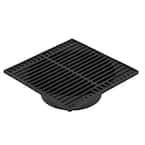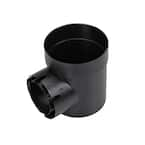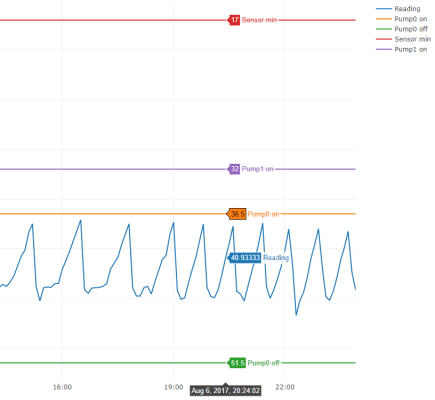ERD50
Give me a museum and I'll fill it. (Picasso) Give me a forum ...
PSA first (as the rest gets [-]a little[/-] long): Check that Sump-Pump, including the entire drain, the entire system!
Some problems are not so obvious. In my new-to-us home, I discovered that the outlet for the sump drain ( typical 4" corrugated plastic pipe that goes out about 25' from the house) was partially blocked. Mostly just grass grown over the perforated end piece (more detail later), so it was easy to make a temporary fix by just raking the grass out of the way and pulling out the perforated cap. This was rather deceptive, and could have led to a BIG problem if I didn't detect it, as when the pump ran a moderate amount, it would drain just fine, so no problem, right? Wrong! More detail on this below.
So check your that your drain is clear and getting the water away from the house. Once a month or so, flip the float to make sure the pump is pumping as expected. Make sure the float is free and clear of any obstructions. Watch the pit during rains to get a baseline for what to expect, so you can tell when something changes. Keep a spare pump on hand, and know how to replace it (not hard at all). And keeping the same model as a spare makes replacing it easier, everything will line up.
Another note on sump drains for those in freezing climates: The PVC outlet is supposed to have an air-gap between it and the 4" drain pipe it flows into. Seems than many are connected directly (as is mine, which I will change before winter). The problem is that w/o an air-gap, if the drain clogs, water comes up and freezes, and your sump is blocked, and you have no indication. At least with an air-gap, water will continue to flow, and you will probably notice the water pooling up around the house (yes, you should be checking regularly!).
More detail: We finally had some bigger rains after a few days of rain that soaked the ground (we had a very dry spring). I'm monitoring the sump pump/pit, as this home has a mostly finished basement, I really, really don't want any water down there! All seems fine. During the dry spring, and even after the light rains, the drain inside the pit was bone dry. Water would come up through the bottom, and the pump would run occasionally (hard to tell how often, it's a submersible and very quiet - a blessing and a curse). Then during this heavier rain, a trickle, then maybe up to a faucet running came from the side drain (maybe 2 GPM max?), so not bad. The pump would kick on for ~ 7 seconds after a few minutes (also more detail on this later).
But as the rain continued, that flow from the side drain turned into a much larger flow - I'd estimate like 5 garden hoses running full? Maybe 15~20 GPM? The 1/2 HP pump (rated 58 GPM at 10' head) would run something like 20 seconds on, 20 seconds off (very rough numbers).
So now I'm concerned about this much higher flow. And it isn't slowing down, even after 10 minutes. So I start to wonder if the gutters are not draining away from the house or something. I go outside to check (luckily, no lightening at the time). Gutters look good, and then I came around back where the 1 1/2" PVC goes into the 4" drain, and I hear the pump come on and... water is gushing out the top of the drain and getting dumped right around the foundation! Yikes! And the nearby gutter drains into the same 4" drain, and water is coming up out of that drain too! So most the water being pumped out is just cycling back to the sump, and this could eventually overcome the capacity of the pump. NOT GOOD!
And as I said above, what is so insidious about this is it all seems normal, as long as the rate is low enough for that partially blocked drain to not back up all the way. Unless I actively monitored this, I would not have known there was any problem until it was too late. I got it cleared, and within about 5 minutes the rate was dropping, and went back to a trickle within the hour. Whew!
OK, even more detail: The sump pump set up looks pretty good, a nice clean install. There is what appears to be a high quality 1/2HP pump, rated 58 GPM at 10' head (Rigid brand - I don't know the quality, but is sure isn't the cheapest pump you can buy if that means anything). And a Watchdog back up pump, with the AGM battery, that pump is rated ~ 30 GPM, so not too shabby (but ideally, it should be as high as the main pump - an outage is usually associated with a storm and rain!). The original boxes are there, and are dated DEC 2019. Check valves in each line, a short run of the 1 1/2" PVC out through the wall to the 4" drain. Because the radon test failed by a small margin and a vent fan system installed, the sump is sealed, but has a window over about half. But I can't easily get in to trip the floats. I might cut out a window and use a gasket and wing nuts to make this easier.
Unfortunately, that Rigid main pump's float is not adjustable, and has only about a 5" range. Inside a sump pit, that's only about 5 gallons, so the pump turns on for ~ 5~7 seconds, then off. That's a lot of cycling - I don't like it. But what to do?
My first thought was to add an external float with one of those "piggyback" switched outlets. Like this:
https://www.homedepot.com/p/Everbilt-Vertical-Float-Switch-for-Sump-Pumps-EBPBV/205618047
I like that because the switch is separate from the pump, and a switch failure doesn't require a new pump (just tie the float on the pump to the ON position). And in an emergency, you can bypass it and just plug the pump in directly to a power strip and manually cycle as needed.
But those don't seem to have much more range, the pump would still short cycle. Hmmmm. I thought about trying to modify the float, but I'm trying to avoid doing all the "MacGyver" things in this house that I did in the old, and keep it simple.
A better idea? So I'm thinking, even if I increase the float range, the main pump will still drain the pit fast (maybe 15 seconds instead of 7 seconds?), and I'm still putting wear and tar on the pump that I really rely on. I started thinking about adding a small third pump and check valve, something less than 5 GPM. I'd put this at the bottom, and raise the main pump ~ 5 inches such that under most conditions, only the small pump would run. This would save wear/tear on my main pump. And that small pump should be cheap to replace anyhow.
I really like this idea, now to find a small, reliable 5 GPM pump that drives a 10' head (many of the small ones have limited head capability). And I'd want the pump to be from a reputable source, so if I have to replace it down the line, I can be reasonably assured it is still available, for an easy swap-out. Though once checked, I'd buy a spare (or maybe two), just in case.
Oh,I almost forgot, the IRONY! When I went out the next morning to clean up the grass at the clogged outlet and investigate the clog further, I picked up a piece of paper that I sort of noticed the night before. It's maybe 2" square. Hey, what's this writing? "WatchDog Pump"? It is the label from the back up pump! So the label came off the pump, got pumped out in one piece, and managed to contribute to the clog (there was also some maple seeds in there)! So ironically, my back up pump was almost responsible for a flooded basement! You just can't win!
Any recommendations for a small pump with at least a 10' head? Thinking about this one, but it's even larger than I need/want ( ~ 24 GPM @ 10').
https://www.amazon.com/Superior-Pump-91250-Submersible-Thermoplastic/dp/B08BLSVHFJ
-ERD50
Some problems are not so obvious. In my new-to-us home, I discovered that the outlet for the sump drain ( typical 4" corrugated plastic pipe that goes out about 25' from the house) was partially blocked. Mostly just grass grown over the perforated end piece (more detail later), so it was easy to make a temporary fix by just raking the grass out of the way and pulling out the perforated cap. This was rather deceptive, and could have led to a BIG problem if I didn't detect it, as when the pump ran a moderate amount, it would drain just fine, so no problem, right? Wrong! More detail on this below.
So check your that your drain is clear and getting the water away from the house. Once a month or so, flip the float to make sure the pump is pumping as expected. Make sure the float is free and clear of any obstructions. Watch the pit during rains to get a baseline for what to expect, so you can tell when something changes. Keep a spare pump on hand, and know how to replace it (not hard at all). And keeping the same model as a spare makes replacing it easier, everything will line up.
Another note on sump drains for those in freezing climates: The PVC outlet is supposed to have an air-gap between it and the 4" drain pipe it flows into. Seems than many are connected directly (as is mine, which I will change before winter). The problem is that w/o an air-gap, if the drain clogs, water comes up and freezes, and your sump is blocked, and you have no indication. At least with an air-gap, water will continue to flow, and you will probably notice the water pooling up around the house (yes, you should be checking regularly!).
More detail: We finally had some bigger rains after a few days of rain that soaked the ground (we had a very dry spring). I'm monitoring the sump pump/pit, as this home has a mostly finished basement, I really, really don't want any water down there! All seems fine. During the dry spring, and even after the light rains, the drain inside the pit was bone dry. Water would come up through the bottom, and the pump would run occasionally (hard to tell how often, it's a submersible and very quiet - a blessing and a curse). Then during this heavier rain, a trickle, then maybe up to a faucet running came from the side drain (maybe 2 GPM max?), so not bad. The pump would kick on for ~ 7 seconds after a few minutes (also more detail on this later).
But as the rain continued, that flow from the side drain turned into a much larger flow - I'd estimate like 5 garden hoses running full? Maybe 15~20 GPM? The 1/2 HP pump (rated 58 GPM at 10' head) would run something like 20 seconds on, 20 seconds off (very rough numbers).
So now I'm concerned about this much higher flow. And it isn't slowing down, even after 10 minutes. So I start to wonder if the gutters are not draining away from the house or something. I go outside to check (luckily, no lightening at the time). Gutters look good, and then I came around back where the 1 1/2" PVC goes into the 4" drain, and I hear the pump come on and... water is gushing out the top of the drain and getting dumped right around the foundation! Yikes! And the nearby gutter drains into the same 4" drain, and water is coming up out of that drain too! So most the water being pumped out is just cycling back to the sump, and this could eventually overcome the capacity of the pump. NOT GOOD!
And as I said above, what is so insidious about this is it all seems normal, as long as the rate is low enough for that partially blocked drain to not back up all the way. Unless I actively monitored this, I would not have known there was any problem until it was too late. I got it cleared, and within about 5 minutes the rate was dropping, and went back to a trickle within the hour. Whew!
OK, even more detail: The sump pump set up looks pretty good, a nice clean install. There is what appears to be a high quality 1/2HP pump, rated 58 GPM at 10' head (Rigid brand - I don't know the quality, but is sure isn't the cheapest pump you can buy if that means anything). And a Watchdog back up pump, with the AGM battery, that pump is rated ~ 30 GPM, so not too shabby (but ideally, it should be as high as the main pump - an outage is usually associated with a storm and rain!). The original boxes are there, and are dated DEC 2019. Check valves in each line, a short run of the 1 1/2" PVC out through the wall to the 4" drain. Because the radon test failed by a small margin and a vent fan system installed, the sump is sealed, but has a window over about half. But I can't easily get in to trip the floats. I might cut out a window and use a gasket and wing nuts to make this easier.
Unfortunately, that Rigid main pump's float is not adjustable, and has only about a 5" range. Inside a sump pit, that's only about 5 gallons, so the pump turns on for ~ 5~7 seconds, then off. That's a lot of cycling - I don't like it. But what to do?
My first thought was to add an external float with one of those "piggyback" switched outlets. Like this:
https://www.homedepot.com/p/Everbilt-Vertical-Float-Switch-for-Sump-Pumps-EBPBV/205618047
I like that because the switch is separate from the pump, and a switch failure doesn't require a new pump (just tie the float on the pump to the ON position). And in an emergency, you can bypass it and just plug the pump in directly to a power strip and manually cycle as needed.
But those don't seem to have much more range, the pump would still short cycle. Hmmmm. I thought about trying to modify the float, but I'm trying to avoid doing all the "MacGyver" things in this house that I did in the old, and keep it simple.
A better idea? So I'm thinking, even if I increase the float range, the main pump will still drain the pit fast (maybe 15 seconds instead of 7 seconds?), and I'm still putting wear and tar on the pump that I really rely on. I started thinking about adding a small third pump and check valve, something less than 5 GPM. I'd put this at the bottom, and raise the main pump ~ 5 inches such that under most conditions, only the small pump would run. This would save wear/tear on my main pump. And that small pump should be cheap to replace anyhow.
I really like this idea, now to find a small, reliable 5 GPM pump that drives a 10' head (many of the small ones have limited head capability). And I'd want the pump to be from a reputable source, so if I have to replace it down the line, I can be reasonably assured it is still available, for an easy swap-out. Though once checked, I'd buy a spare (or maybe two), just in case.
Oh,I almost forgot, the IRONY! When I went out the next morning to clean up the grass at the clogged outlet and investigate the clog further, I picked up a piece of paper that I sort of noticed the night before. It's maybe 2" square. Hey, what's this writing? "WatchDog Pump"? It is the label from the back up pump! So the label came off the pump, got pumped out in one piece, and managed to contribute to the clog (there was also some maple seeds in there)! So ironically, my back up pump was almost responsible for a flooded basement! You just can't win!
Any recommendations for a small pump with at least a 10' head? Thinking about this one, but it's even larger than I need/want ( ~ 24 GPM @ 10').
https://www.amazon.com/Superior-Pump-91250-Submersible-Thermoplastic/dp/B08BLSVHFJ
-ERD50
Last edited:



